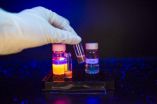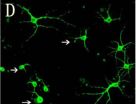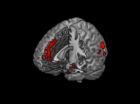(Press-News.org) DALLAS – March 28, 2014 – UT Southwestern Medical Center researchers are developing a new predictive tool that could help patients with breast cancer and certain lung cancers decide whether follow-up treatments are likely to help.
Dr. Jerry Shay, Vice Chairman and Professor of Cell Biology at UT Southwestern, led a three-year study on the effects of irradiation in a lung cancer-susceptible mouse model. When his team looked at gene expression changes in the mice, then applied them to humans with early stage cancer, the results revealed a breakdown of which patients have a high or low chance of survival.
The findings, published online in Clinical Cancer Research, offer insight into helping patients assess treatment risk. Radiation therapy and chemotherapy that can destroy tumors also can damage surrounding healthy tissue. So with an appropriate test, patients could avoid getting additional radiation or chemotherapy treatment they may not need, Dr. Shay said.
"This finding could be relevant to the many thousands of individuals affected by these cancers and could prevent unnecessary therapy," said Dr. Shay, Associate Director for Education and Training for the Harold C. Simmons Comprehensive Cancer Center at UT Southwestern. "We're trying to find better prognostic indicators of outcomes so that only patients who will benefit from additional therapy receive it."
Dr. Shay's study closely monitored lung cancer development in mice after irradiation. His group found some types of irradiation resulted in an increase in invasive, more malignant tumors. He examined the gene expression changes in mice well before some of them developed advanced cancers. The genes in the mouse that correlated with poor outcomes were then matched with human genes. When Dr. Shay's team compared the predictive signatures from the mice with more than 700 human cancer patient signatures, the overall survivability of the patients correlated with his predictive signature in the mice. Thus, the classifier that predicted invasive cancer in mice also predicted poor outcomes in humans.
His study looked at adenocarcinoma, a type of lung cancer in the air sacks that afflicts both smokers and non-smokers. The findings also predicted overall survival in patients with early-stage breast cancer and thus offer the same helpful information to breast cancer patients; however the genes were not predictive of another type of lung cancer, called squamous cell carcinoma. Other types of cancers have yet to be tested.
The American Cancer Society estimates the risk of developing lung cancer to be 1 in 13 for men and 1 in 16 for women, including both smokers and non-smokers. Lung cancer is the second most common cancer in both men and women, accounting for about 13 percent of all new cancers, and about 27 percent of cancer deaths. The American Cancer Society estimates more than 224,210 new cases of lung cancer and nearly 160,000 deaths from lung cancer will occur in 2014. Survival statistics vary depending on the stage of the cancer and when it is diagnosed.
Dr. Shay's research is paid for in part by a five-year grant from NASA, which helps fund cancer research due to cancer risks faced by astronauts during space missions.
The findings could lead to more individualized care and pave the way to better, more science-based care and decision making, he said.
"Personalized medicine is coming," Dr. Shay said. "I think this is the future – patients looking at their risks of cancer recurrence and deciding what to do next. We can better tailor the treatment to fit the individual. That's the goal."
INFORMATION:
About UT Southwestern Medical Center
UT Southwestern, one of the premier academic medical centers in the nation, integrates pioneering biomedical research with exceptional clinical care and education. The institution's faculty includes many distinguished members, including five who have been awarded Nobel Prizes since 1985. Numbering more than 2,700, the faculty is responsible for groundbreaking medical advances and is committed to translating science-driven research quickly to new clinical treatments. UT Southwestern physicians provide medical care in 40 specialties to nearly 90,000 hospitalized patients and oversee more than 1.9 million outpatient visits a year.
Gene may predict if further cancer treatments are needed
2014-03-28
ELSE PRESS RELEASES FROM THIS DATE:
Erectile dysfunction can be reversed without medication
2014-03-28
Men suffering from sexual dysfunction can be successful at reversing their problem, by focusing on lifestyle factors and not just relying on medication, according to research at the University of Adelaide.
In a new paper published in the Journal of Sexual Medicine, researchers highlight the incidence of erectile dysfunction and lack of sexual desire among Australian men aged 35-80 years.
Over a five-year period, 31% of the 810 men involved in the study developed some form of erectile dysfunction.
"Sexual relations are not only an important part of people's wellbeing. ...
NUS researchers developed world's first fluorescent sensor to detect date rape drug
2014-03-28
A team of researchers from the National University of Singapore (NUS) has developed the world's first fluorescent sensor to identify the presence of a drug known as GHB that is commonly used to spike beverages. When the sensor is mixed with a sample of a beverage containing GHB, the mixture changes colour in less than 30 seconds, making detection of the drug fast and easy.
This simple mix-and-see discovery, led by Professor Chang Young-Tae of the Department of Chemistry at the NUS Faculty of Science, is a novel scientific breakthrough that contributes towards prevention ...
More male fish 'feminized' by pollution on the Basque coast
2014-03-28
The UPV/EHU's Cell Biology in Environmental Toxicology group has conducted research using thick-lipped grey mullet and has analysed specimens in six zones: Arriluze and Gernika in 2007 and 2008, and since then, Santurtzi, Plentzia, Ondarroa, Deba and Pasaia. The acquisition of feminine features by male fish has been detected, to a greater or lesser extent, in all the estuaries, not only in the characteristics of the gonads of the specimens analysed but also in various molecular markers. According to Miren P. Cajaraville, director of the research group, the results show ...
Fingerprint of dissolved glycine in the Terahertz range explained
2014-03-28
Chemists at the Ruhr-Universität Bochum (RUB) have, for the first time, completely analysed the fingerprint region of the Terahertz spectrum of a biologically relevant molecule in water, in this case, an amino acid. By combining spectroscopy and molecular-dynamics simulations, they rendered the motion of the most basic amino acid, glycine, visible in an aqueous solution. Their results have disproved the long-standing theory that frequencies in the Terahertz range provide no information regarding the amino acid's motion. The team led by Prof Dr Martina Havenith-Newen and ...
Aspartic acid in the hippocampus: A biomarker for postoperative cognitive dysfunction
2014-03-28
Postoperative cognitive dysfunction is the deterioration of cognitive performance after anesthesia and surgery, and manifests as impairments in short-term memory, concentration, language comprehension, and social integration skills. Previous studies have shown that the occurrence of postoperative cognitive dysfunction is affected by many factors, including advanced age, low educational level, pre-existing cognitive impairment, alcohol abuse, and severity of coexisting illness. However, the real cause for postoperative cognitive dysfunction is still unclear. Metabolite changes ...
Ancient African cattle first domesticated in Middle East, MU study reveals
2014-03-28
COLUMBIA, Mo. – Geneticist and anthropologists previously suspected that ancient Africans domesticated cattle native to the African continent nearly 10,000 years ago. Now, a team of University of Missouri researchers has completed the genetic history of 134 cattle breeds from around the world. In the process of completing this history, they found that ancient domesticated African cattle originated in the "Fertile Crescent," a region that covered modern day Iraq, Jordan, Syria and Israel.
Lead researcher Jared Decker, an assistant professor of animal science in the MU ...
Religion, spirituality influence health in different but complementary ways
2014-03-28
CORVALLIS, Ore. – Religion and spirituality have distinct but complementary influences on health, new research from Oregon State University indicates.
"Religion helps regulate behavior and health habits, while spirituality regulates your emotions, how you feel," said Carolyn Aldwin, a gerontology professor in the College of Public Health and Human Sciences at OSU.
Aldwin and colleagues have been working to understand and distinguish the beneficial connections between health, religion and spirituality. The result is a new theoretical model that defines two distinct pathways. ...
Brain scans link concern for justice with reason, not emotion
2014-03-28
People who care about justice are swayed more by reason than emotion, according to new brain scan research from the University of Chicago Department of Psychology and Center for Cognitive and Social Neuroscience.
Psychologists have found that some individuals react more strongly than others to situations that invoke a sense of justice—for example, seeing a person being treated unfairly or mercifully. The new study used brain scans to analyze the thought processes of people with high "justice sensitivity."
"We were interested to examine how individual differences about ...
Researchers identify good bacteria that protects against HIV
2014-03-28
Researchers at the University of Texas Medical Branch at Galveston by growing vaginal skin cells outside the body and studying the way they interact with "good and bad" bacteria, think they may be able to better identify the good bacteria that protect women from HIV infection and other sexually transmitted infections.
The health of the human vagina depends on a symbiotic/mutually beneficial relationship with "good" bacteria that live on its surface feeding on products produced by vaginal skin cells. These good bacteria, in turn, create a physical and chemical barrier ...
Underweight people at as high risk of dying as obese people, new study finds
2014-03-28
TORONTO, March 28, 2014—Being underweight puts people at highest risk of dying, just as obesity does, new research has found.
The connection between being underweight and the higher risk of dying is true for both adults and fetuses. This is so even when factors such as smoking, alcohol use or lung disease are considered, or adults with a chronic or terminal illness are excluded, the study found.
The study, led by Dr. Joel Ray, a physician-researcher at St. Michael's Hospital and the hospital's Li Ka Shing Knowledge Institute, was published today in the Journal of Epidemiology ...





